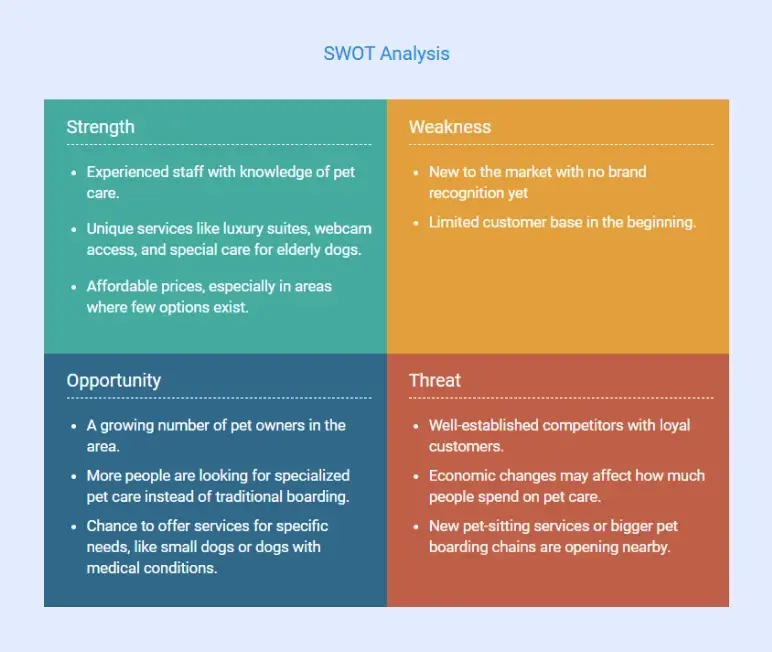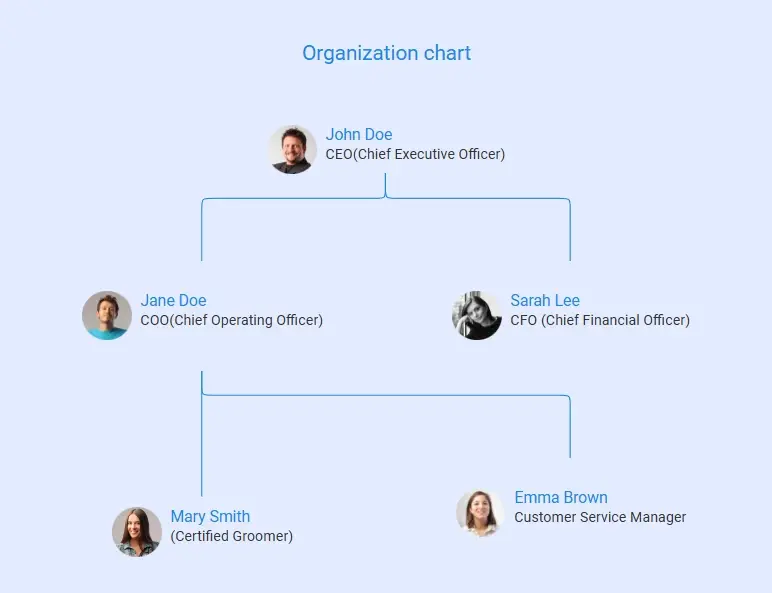Thinking about starting a dog kennel? It’s a great idea: A business that combines your love for animals with the chance to make a real difference in pet owners’ lives.
But there’s more to it than just playing with puppies!
You’ll need to create a solid plan that helps manage bookings, ensure safety standards, and market your services effectively.
Wondering how to draft a plan? Not to worry!
This dog kennel business plan template is here to help you create a plan that works best for you!
Why is a dog kennel business plan important?
A dog kennel business plan isn’t just a document; it’s your roadmap to success.
Whether you’re planning a small home-based boarding operation or a large commercial kennel facility, a well-crafted business plan will guide you through each stage of your business. It keeps you organized, focused, and prepared as you move from concept to execution.
Here’s why having a plan is a must-have for your dog kennel:
- Gives you clear direction by organizing your ideas and setting specific goals for services, capacity, and ideal customers.
- Attracts investors and builds trust by showing lenders you’ve done your homework and have a clear strategy to make the business profitable.
- Ensures you meet legal and safety requirements, including zoning, licensing, health regulations, and vaccination policies.
- Prepares you for challenges like seasonal dips, local competition, or emergency situations with pets.
- Supports smart financial planning by helping you estimate startup costs, operating expenses, and revenue streams.
- Helps you stay focused when multiple tasks demand your attention and serves as a go-to guide for day-to-day decisions.
Now that you know why a business plan is so important, let’s dive into how to create one for your dog kennel step by step.
How to write a dog kennel business plan?
Writing a dog kennel business plan is much easier when you break it into sections.
Below, we’ll guide you through each key component of a successful dog kennel business plan, explaining what to include and giving tips along the way. Follow these steps to craft a plan that covers all the bases:
1. Executive Summary
The executive summary is a short overview of your dog kennel business plan. It’s the first section of your plan, but it’s best to write it last, after the other sections are completed.
Think of it as an elevator pitch for your dog kennel. In 1-2 pages, it should highlight the most important information and grab the reader’s attention.
A strong summary should answer a few key questions an investor or potential partner might ask. For instance:
- What is your kennel concept?
- Who are your target customers?
- What problem are you solving for pet owners?
- Where is your kennel located, and what’s the advantage of your location?
- How many dogs can you accommodate, and what services will you offer?
- How will you market your services and attract clients?
- What are your financial projections and needs? How much funding do you need?
By addressing these points, you give readers a clear snapshot of your dog kennel business. Hence, keep it concise, engaging, and focused on the highlights.
This section is often the first thing investors read, so make it count. Aim for a 1-page, punchy overview that sparks interest.
Say goodbye to boring templates
Build your business plan faster and easier with AI
Plans starting from $14/month

2. Business Description
The company overview explains what your dog kennel business is all about—who runs it, what it offers, and what it stands for. To give a clear view of your structure, goals, and direction, focus on these key points:
- Business details: The name, location, and a brief description of the operation or your facility
- Legal structure: Identify if you are operating as an LLC, a sole proprietorship, or another entity, and why this entity fits your dog kennel business ideally.
- Mission statement: What does your kennel stand for? For example, providing safe, loving, and reliable dog care.
- Owner background: Provide a brief synopsis of the founder’s experience in animal care, business, or any related fields.
- Core services: Short list of core offerings–boarding, daycare, grooming, training.
- Business objectives: What are your short-term and long-term goals?
This overview helps build trust and shows that the kennel is backed by thoughtful planning. It sets the stage for the rest of your business plan with clarity and purpose.
3. Industry and Market Analysis
In the market research section, show that you understand the pet care industry and the local market for your kennel. This section proves there’s demand for your services and that you know the market you’re entering.
Begin with a quick industry overview. The pet boarding business is on the rise due to increasing numbers of pet owners and their eagerness to pay for good care.
For instance, the pet boarding market is predicted to expand from $20 billion to $36 billion by the year 2031 as boarding demand increases because of hectic lifestyles.
Now, take a look at your local market. Think about how many people in the neighborhood have pets and what they want. This will determine your target customers.
Do they require professionals for overnight care? Do they desire luxury options or budget care?
Know their needs and wants. The more you understand the target audience, the better it will be to customize your service to suit them.
To achieve this, you might want to construct a customer persona of your dream pet owners so that you can get a better idea of what they would seek in a dog kennel.

This assists you in having a better understanding of your target customer, their preferences, goals, and sore spots. You can even use this to inform your services and marketing efforts.
4. Competitive Analysis
The competitive analysis section helps you understand your primary competitors and shows how your dog kennel will stand out in the market.
Start by identifying your main competitors, including other doggy daycares, pet hotels, or veterinary clinics that offer boarding in your area. Analyze a few direct competitors by considering questions like:
- How many dogs can they accommodate?
- What services do they offer?
- What are their strengths and weaknesses?
This analysis will help you determine where your business can fill gaps and offer unique value.
Perhaps you find that a competitor’s facility is always full, showing high demand. Or maybe existing kennels lack specific features like 24-hour supervision, which could be an opportunity for your kennel to stand out.
Highlight the gap your kennel will fill. Discuss what will make your kennel unique, like:
- Luxury suites and live camera feed for owners to watch their pets.
- Special care for elderly or medication-needing dogs.
- More affordable pricing or extended drop-off hours.
By focusing on what sets you apart from competitors, you can carve out a niche that will attract loyal customers.
If required, use a SWOT analysis (Strengths, Weaknesses, Opportunities, and Threats) to assess your market. Identify your strengths to stand out, address weaknesses, spot growth opportunities, and prepare for threats. This shows investors that you have a clear strategy to compete and succeed.

5. Service Offerings
When you’re operating a successful dog kennel, the services you provide are the key to attracting and keeping customers.
Your services are what will actually address the needs of your customers and their pets directly, and they are the foundation of your income stream.
By providing multiple services, you can boost your income and attract more clients. Below, we’ll outline the necessary services and extras you may provide for your dog kennel.
Below, we’ll outline the necessary services you may provide for your dog kennel.
- Overnight stays
- Dog daycare
- Grooming services
- Training classes
Next, think about extra services that can make life easier for pet owners and set your kennel apart from basic boarding options. This might include:
- Pickup and drop-off
- Grooming before pickup
- Retail sales like pet food, toys, or accessories
Once you’ve listed your services, add a simple breakdown of your pricing. You can also offer package deals or first-time customer discounts to encourage loyalty and make your services more affordable.
6. Marketing Strategy
The best kennel is not the end-all. You must market and sell to keep the clients coming back.
This section of your business plan is where you explain how you’ll identify and get customers, convince them to use your kennel, and keep them returning every time.
Here are some key methods and strategies to include in your marketing and promotion plan:
- Create your kennel’s name, logo, and branding. Ensure it fits your target audience if you’re looking to provide a friendly, affordable center or a luxury experience.
- Build a website and begin marketing through social media like Facebook and Instagram- share your kennel services, happy pets, and testimonials to build credibility and create visibility online.
- Use advertising in the community, flyers, ads in local magazines and newspapers, or local cable television. Special promotions or discounts can entice new customers to try your services.
- Offer marketing bundle deals to local groomers, animal clinics, and pet store-and referral network agreements. This increases your visibility and local presence.
- Make your booking system easy to use. Provide online reservations and have a simple means through which customers can check for availability and services.
- Maintain customers’ interest via email newsletters, loyalty programs, and follow-ups. This has the effect of converting one-off visitors to recurring customers.
In general, your marketing and sales strategy must be simple and concentrated. You don’t require a large budget to promote your kennel well.
Clever utilization of online tools and establishing local alliances can take you a long way. Just ensure that you spend some budget on promotions and advertising.
7. Management Team
This management team section highlights who is running the dog kennel and why they’re capable of making it a success.
Start with your profile. As the owner/founder, provide an overview of your experience and qualifications. If you have co-founders or key team members, mention them here. List their names, roles, educational qualifications, and relevant experience.
Next, describe how your team is structured. In a small business, the structure might be simple, but it’s still important to outline.
It’s a good idea to include an organizational chart for clarity, especially if the team is larger. For instance:

When writing about your support network, mention any advisors or outside experts who help strengthen your business. These can be professionals who offer guidance in areas beyond your core team’s day-to-day roles.
For example, you might note that your kennel is supported by:
- A veterinary advisor who helps shape your health and safety protocols
- An experienced startup mentor who offers business guidance
Be clear about what their support brings to the table. Their input can improve your operations, refine safety practices, and help with long-term planning. This shows lenders or investors that you’ve filled key gaps in knowledge and aren’t working alone in critical areas.
8. Operations Plan
This section outlines how your kennel will run on a day-to-day basis, from facilities to staffing and the processes that allow smooth service.
So, you should demonstrate that you have a well-thought-out, structured plan for providing quality care and services every day.
Here’s how you can structure your operations plan:
| Key Element | Details |
|---|---|
| Facility and Layout | Number of dog suites, play areas, security features, and unique features like a dog pool or security camera. |
| Capacity and Schedule | Operating hours, daily dog schedule (feeding, playtime, rest), and staff supervision details. |
| Staffing and Roles | Staff needed, staff-to-dog ratio, and necessary training. |
| Operational Processes | Check-in/check-out procedures, feeding schedules, sanitation, health and safety protocols, and record-keeping. |
| Suppliers and Inventory | Suppliers for food, cleaning supplies, and other essentials, along with inventory management. |
| Scaling and Backup Plans | Plans for business growth and handling emergencies or weather-related issues. |
This will help you present the important operational elements of your kennel and show that you have a well-defined, systematic plan for efficient and smooth operations. It also gives investors confidence that the business will run well, providing excellent care for pets.
9. Financial Plan
The financial plan is an essential component of your dog kennel business plan. It indicates the financial projections for the next 3-5 years and proves the viability of your dog kennel business.
This section shows that your company can make a profit and remain financially stable in the long term.
The following are the key factors to include in this section:
- Startup expenses: Include one-time costs like facility remodeling, equipment, licenses, advertising, and provisions.
- Revenue projections: Project income from services such as overnight stays, daycare, and grooming.
- Expense projections: Incorporate monthly operating expenses such as rent, utilities, employees’ salaries, supplies, and insurance.
- Tax considerations: Describe possible tax liabilities and how to manage them.
- Profit & loss projection: Offer a straightforward description of projected profit or loss for several years.
- Cash flow projections: Plan how cash will come into and leave the business to ensure it doesn’t run out.
- Break-even analysis: Estimate how many dogs staying overnight are required to break even.
If you need to finance the establishment or expansion of your kennel, indicate how much you need and for what purpose. If you’re not asking for external capital, state that the business will be self-funded or financed by personal savings.
Download a free dog kennel business plan template
Ready to create your own dog kennel business plan but need a little extra help? We’ve got you covered. Download our free dog kennel business plan template (PDF) to jumpstart your planning.
This template comes pre-filled with example content and a detailed outline for all sections, making it easy to customize for your needs. It saves you time and ensures you don’t miss any important details, providing a perfect starting point for drafting your plan.
The Quickest Way to turn a Business Idea into a Business Plan
Fill-in-the-blanks and automatic financials make it easy.
Conclusion
Let’s wrap it up! We’ve covered all the key sections of a dog kennel business plan and how to write them. Plus, we’ve provided a free sample business plan to help you. Now, it should be much easier for you to draft your own dog kennel business plan.
However, if you’re still unsure about details or looking for an easier way to create your plan, tools like Upmetrics can be incredibly helpful.
With advanced AI capabilities, financial forecasting features, free templates, and additional resources, it streamlines the planning process, making it faster and easier to create a comprehensive, actionable plan.



